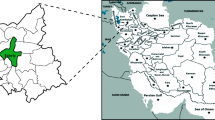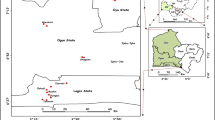Abstract
This study aimed to evaluate the health risks of cadmium (Cd), lead (Pb), inorganic arsenic (As), and nitrate exposure through the consumption of bivalves and vegetables collected from local markets in Ho Chi Minh City. The present study analyzed four favorite bivalve species (Meretrix lyrate; Perna viridis; Anadara subcrenata; Anadara granosa) for concentrations of Cd, Pb, and inorganic As and 9 vegetable species (Brassica juncea; Brassica integrifolia; Brassica rapa chinensis; Nasturtium officinale; Lactuca sativa; Ipomoea aquatica; Amaranthus gangeticus; Ipomoea batatas; Spinacia oleracea) for concentrations of Pb and nitrate. The target hazard quotient (THQ) and target cancer risk (TR) were calculated to estimate non-carcinogenic and carcinogenic health risks, respectively. For bivalves, Cd and inorganic As were present at relatively lower concentrations, whereas a relatively higher accumulation of Pb was recorded. The THQ for Cd, Pb, or inorganic As was below the threshold of 1, suggesting no potential health risks. In the case of vegetables, Pb was present at relatively low concentrations, while nitrate accumulation was at relatively high concentrations. The THQ for nitrate was higher than the threshold of 1, suggesting a potential health risk. The combined effects are estimated according to the hazard index (HI), which shows the health risks associated with the consumption of these bivalves and vegetable species. Therefore, continuous and excess consumption for a lifetime of more than 70 years has a probability of target cancer risk.
Similar content being viewed by others
References
Ahmed MK, Baki MA, Islam MS, Kundu GK, Habibullah-al-Mamun M, Sarkar SK, Hossain MM (2015) Human health risk assessment of heavy metals in tropical fish and shellfish collected from the river Buriganga, Bangladesh. Environ Sci Pollut Res 22(20):15880–15890. https://doi.org/10.1007/s11356-015-4813-z
Ali H, Khan E (2019) Trophic transfer, bioaccumulation, and biomagnification of non-essential hazardous heavy metals and metalloids in food chains/webs—concepts and implications for wildlife and human health. Human Ecol Risk Assesst An Int J 25(6):1353–1376. https://doi.org/10.1080/10807039.2018.1469398
Ali H, Khan E, Ilahi I (2019) Environmental chemistry and ecotoxicology of hazardous heavy metals: environmental persistence, toxicity, and bioaccumulation. J Chem 2019:6730305–6730314. https://doi.org/10.1155/2019/6730305
Baki M, Hossain MM, Akter J et al (2018) Concentration of heavy metals in seafood (fishes, shrimp, lobster and crabs) and human health assessment in Saint Martin Island, Bangladesh. Ecotoxicol Environ Saf 159:153–163. https://doi.org/10.1016/j.ecoenv.2018.04.035
Boudebbouz A, Boudalia S, Bousbia A, Habila S, Boussadia MI, Gueroui Y (2021) Heavy metals levels in raw cow milk and health risk assessment across the globe: a systematic review. Sci Total Environ 751:141830. https://doi.org/10.1016/j.scitotenv.2020.141830
Burioli EAV, Squadrone S, Stella C, Foglini C, Abete MC, Prearo M (2017) Trace element occurrence in the Pacific oyster Crassostrea gigas from coastal marine ecosystems in Italy. Chemosphere 187:248–260. https://doi.org/10.1016/j.chemosphere.2017.08.102
Cantliffe DJ (1973) Nitrate accumulation in table beets and spinach as affected by nitrogen, phosphorus, and potassium nutrition and light intensity1. Agron J 65(4):563–565. https://doi.org/10.2134/agronj1973.00021962006500040012x
Charkiewicz AE, Backstrand JR (2020) Lead toxicity and pollution in Poland. Int J Environ Res Public Health 17(12):4385. https://doi.org/10.3390/ijerph17124385
Cheng WWL, Gobas FAPC (2007) Assessment of human health risks of consumption of cadmium contaminated cultured oysters. Human Ecol Risk Assesst An Int J 13(2):370–382. https://doi.org/10.1080/10807030701226301
Chi Q-q, Zhu G-w, Langdon A (2007) Bioaccumulation of heavy metals in fishes from Taihu Lake, China. J Environ Sci 19(12):1500–1504. https://doi.org/10.1016/S1001-0742(07)60244-7
Chung SY, Kim JS, Kim M, Hong MK, Lee JO, Kim CM, Song IS (2003) Survey of nitrate and nitrite contents of vegetables grown in Korea. Food Addit Contam 20(7):621–628. https://doi.org/10.1080/0265203031000124146
Correia M, Barroso Â, Barroso MF, Soares D, Oliveira MBPP, Delerue-Matos C (2010) Contribution of different vegetable types to exogenous nitrate and nitrite exposure. Food Chem 120(4):960–966. https://doi.org/10.1016/j.foodchem.2009.11.030
Díaz-Somoano M, Kylander ME, López-Antón MA, Suárez-Ruiz I, Martínez-Tarazona MR, Ferrat M, Kober B, Weiss DJ (2009) Stable lead isotope compositions in selected coals from round the world and implications for present day aerosol source tracing. Environ Sci Technol 43(4):1078–1085. https://doi.org/10.1021/es801818r
EC (2006) European commission, Commission regulation (EC) No 1881/2006 of of 19 December 2006 setting maximum levels for certain contaminants in foodstuffs. Off J European Comm L 364:5–24. https://doi.org/10.1039/c5cp00649j
Espejo-Herrera N, Gràcia-Lavedan E, Boldo E, Aragonés N, Pérez-Gómez B, Pollán M, Molina AJ, Fernández T, Martín V, la Vecchia C, Bosetti C, Tavani A, Polesel J, Serraino D, Gómez Acebo I, Altzibar JM, Ardanaz E, Burgui R, Pisa F, Fernández-Tardón G, Tardón A, Peiró R, Navarro C, Castaño-Vinyals G, Moreno V, Righi E, Aggazzotti G, Basagaña X, Nieuwenhuijsen M, Kogevinas M, Villanueva CM (2016) Colorectal cancer risk and nitrate exposure through drinking water and diet. Int J Cancer 139(2):334–346. https://doi.org/10.1002/ijc.30083
FAO/WHO (1993) Evaluation of certain food additives and contaminants. In: 837 WTRSN (Ed), 41st Report of the Joint FAO/WHO Expert Committee on Food Additives Food and Agriculture Organization/World Health Organization
Fiamegkos I, Cordeiro F, Devesa V et al (2015) IMEP-41: determination of inorganic As in food. Int J Environ Res Public Health 17. https://doi.org/10.3390/ijerph17113782
FSANZ (2008) Australia New Zealand Food Standards Code (Incorporating amendments up to and including Amendment 97). Anstat Pty Ltd, Melbourne 17:10160–10169. https://doi.org/10.1039/c5cp00649j
García-Rico L, Tejeda-Valenzuela L (2020) Metal concentrations in oysters Crassostrea gigas cultured in the gulf of California and risk assessment to human health. Exposure Health 12:33–39. https://doi.org/10.1007/s12403-018-0281-2
Genchi G, Sinicropi MS, Lauria G, Carocci A, Catalano A (2020) The effects of cadmium toxicity. Int J Environ Res Public Health 17(11):3782. https://doi.org/10.3390/ijerph17113782
Habermeyer M, Roth A, Guth S, Diel P, Engel KH, Epe B, Fürst P, Heinz V, Humpf HU, Joost HG, Knorr D, de Kok T, Kulling S, Lampen A, Marko D, Rechkemmer G, Rietjens I, Stadler RH, Vieths S, Vogel R, Steinberg P, Eisenbrand G (2015) Nitrate and nitrite in the diet: how to assess their benefit and risk for human health. Mol Nutr Food Res 59(1):106–128. https://doi.org/10.1002/mnfr.201400286
Inoue-Choi M, Jones RR, Anderson KE, Cantor KP, Cerhan JR, Krasner S, Robien K, Weyer PJ, Ward MH (2015) Nitrate and nitrite ingestion and risk of ovarian cancer among postmenopausal women in Iowa. Int J Cancer 137(1):173–182. https://doi.org/10.1002/ijc.29365
Joint FAOWHOECoFA, World Health O, Food, Agriculture Organization of the United N (1993) Evaluation of certain food additives and contaminants. Forty-frst report of the Joint FAO/WHO Expert Committee on Food Additives World Health Organization, Technical Report Series 837 WHO, Geneva, Switzerland. World Health Organization
Kilfoy BA, Zhang Y, Park Y, Holford TR, Schatzkin A, Hollenbeck A, Ward MH (2011) Dietary nitrate and nitrite and the risk of thyroid cancer in the NIH-AARP Diet and Health Study. Int J Cancer 129(1):160–172. https://doi.org/10.1002/ijc.25650
Lundberg JO, Weitzberg E, Gladwin MT (2008) The nitrate–nitrite–nitric oxide pathway in physiology and therapeutics. Nat Rev Drug Discov 7(2):156–167. https://doi.org/10.1038/nrd2466
Mandal BK, Suzuki KT (2002) Arsenic round the world: a review. Talanta 58(1):201–235. https://doi.org/10.1016/S0039-9140(02)00268-0
Mensinga TT, Speijers GJA, Meulenbelt J (2003) Health implications of exposure to environmental nitrogenous compounds. Toxicol Rev 22(1):41–51. https://doi.org/10.2165/00139709-200322010-00005
MHV (1998) Ministry of Health of Vietnam, Decision 867/1998 / QD-BYT of the Ministry of Health promulgating the list of hygiene standards for food and foodstuff
Mirvish SS (1995) Role of N-nitroso compounds (NOC) and N-nitrosation in etiology of gastric, esophageal, nasopharyngeal and bladder cancer and contribution to cancer of known exposures to NOC. Cancer Lett 93(1):17–48. https://doi.org/10.1016/0304-3835(95)03786-v
Mok JS, Yoo HD, Kim PH, Yoon HD, Park YC, Lee TS, Kwon JY, Son KT, Lee HJ, Ha KS, Shim KB, Kim JH (2015) Bioaccumulation of heavy metals in oysters from the southern coast of Korea: assessment of potential risk to human health. Bull Environ Contam Toxicol 94(6):749–755. https://doi.org/10.1007/s00128-015-1534-4
NYSDOH (2007) Hopewell precision area contamination: appendix C-NYS DOH. Procedure for evaluating potential health risks for contaminants of concern. http://www.health.ny.gov/environmental/investigations/hopewell/appendc.htm
Pobel D, Riboli E, Cornée J, Hémon B, Guyader M (1995) Nitrosamine, nitrate and nitrite in relation to gastric cancer: a case-control study in Marseille, France. Eur J Epidemiol 11(1):67–73. https://doi.org/10.1007/bf01719947
Quist AJL, Inoue-Choi M, Weyer PJ, Anderson KE, Cantor KP, Krasner S, Freeman LEB, Ward MH, Jones RR (2018) Ingested nitrate and nitrite, disinfection by-products, and pancreatic cancer risk in postmenopausal women. Int J Cancer 142(2):251–261. https://doi.org/10.1002/ijc.31055
Saher NU, Kanwal N (2019) Assessment of some heavy metal accumulation and nutritional quality of shellfish with reference to human health and cancer risk assessment: a seafood safety approach. Environ Sci Pollut Res 26(5):5189–5201. https://doi.org/10.1007/s11356-018-3764-6
Santamaria P (2006) Nitrate in vegetables: toxicity, content, intake and EC regulation. J Sci Food Agric 86(1):10–17. https://doi.org/10.1002/jsfa.2351
Shenai-Tirodkar PS, Gauns MU, Ansari ZA (2016) Concentrations of heavy metals in commercially important oysters from Goa, Central-West Coast of India. Bull Environ Contam Toxicol 97(6):813–819. https://doi.org/10.1007/s00128-016-1956-7
Stoica A, Pentecost E, Martin MB (2000) Effects of arsenite on estrogen receptor-α expression and activity in MCF-7 breast cancer cells*. Endocrinology 141(10):3595–3602. https://doi.org/10.1210/endo.141.10.7704
Thang NQ, Phuong NTK, Van Tan L (2017) Endocrine stress response in Oreochromis sp. from exposure to waterborne cadmium: the plasma cortisol analysis. Toxicol Environ Chem 99(2):285–293. https://doi.org/10.1080/02772248.2016.1172583
Thompson J, Bannigan J (2008) Cadmium: toxic effects on the reproductive system and the embryo. Reprod Toxicol 25(3):304–315. https://doi.org/10.1016/j.reprotox.2008.02.001
USEPA (2011) EPA Regional Screening Level (RSL) Summary Table: November 2011.
USEPA (2012) EPA Region III Risk-based Concentration (RBC) Table 2008 Region III, 1650 Arch Street, Philadelphia, Pennsylvania 19103
Walker R (1990) Nitrates, nitrites and N-nitrosocompounds: a review of the occurrence in food and diet and the toxicological implications. Food Addit Contam 7(6):717–768. https://doi.org/10.1080/02652039009373938
Wani AL, Ara A, Usmani JA (2015) Lead toxicity: a review. Interdiscip Toxicol 8(2):55–64. https://doi.org/10.1515/intox-2015-0009
Xiong B, Xu T, Li R, Johnson D, Ren D, Liu H, Xi Y, Huang Y (2020) Heavy metal accumulation and health risk assessment of crayfish collected from cultivated and uncultivated ponds in the Middle Reach of Yangtze River. Sci Total Environ 739:139963. https://doi.org/10.1016/j.scitotenv.2020.139963
Availability of data and materials
The data used to support the findings of this study are available from the corresponding author upon request.
Author information
Authors and Affiliations
Contributions
All authors contributed to portions of the study conception and design. Sampling and sample preparation was performed by Dang Nguyen Nha Khanh, Ngo Thi Tuong Vy, Tran Ha Phuong, and Le Thi Tham. Chemical analysis was performed by Nguyen Quoc Thang, Bui The Huy, Do Trung Sy, and Nguyen Thi Kim Phuong. The first draft of the manuscript was written by Nguyen Thi Kim Phuong, and all authors commented on previous versions of the manuscript. All authors read and approved the final manuscript.
Corresponding author
Ethics declarations
Ethics approval and consent to participate
Not applicable.
Consent for publication
Not applicable.
Competing interests
The authors declare competing interests.
Additional information
Responsible Editor: Lotfi Aleya
Publisher’s note
Springer Nature remains neutral with regard to jurisdictional claims in published maps and institutional affiliations.
Rights and permissions
About this article
Cite this article
Thang, N.Q., Huy, B.T., Khanh, D.N.N. et al. Potential health risks of toxic heavy metals and nitrate via commonly consumed bivalve and vegetable species in Ho Chi Minh City, Vietnam. Environ Sci Pollut Res 28, 54960–54971 (2021). https://doi.org/10.1007/s11356-021-14808-3
Received:
Accepted:
Published:
Issue Date:
DOI: https://doi.org/10.1007/s11356-021-14808-3




